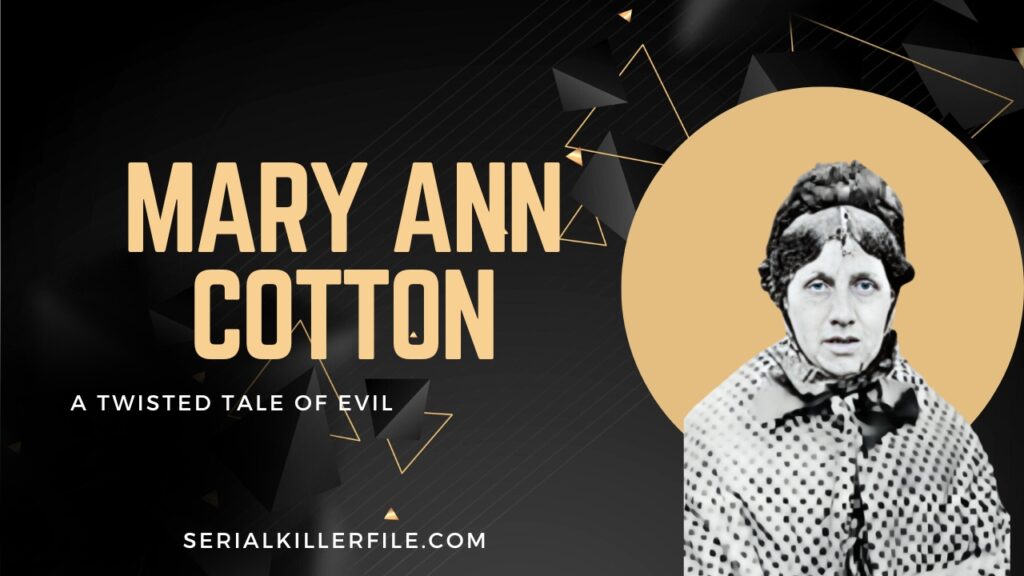Mary Ann Cotton (née Robson) is a name etched in infamy. She was a notorious English serial killer, and her dark deeds sent shivers down the spines of those who crossed her path. Born on October 31, 1832, in Low Moorsley, County Durham, she came to be known as one of the most prolific female serial killers in history. Her story is a chilling tale of crime and deception that unfolded over the years. Her chilling story is one of deception, poison, and Similarly an insatiable lust for money and power.

Mary Ann Cotton Story
In this paragraph, we will delve into the chilling life of Robson. Mary Ann’s name became synonymous with terror and murder. She was a 19th-century Englishwoman convicted of one of the most gruesome crime sprees in history. However, join me as we explore the life, crimes, and psychological aspects of Robson, a woman whose deeds continue to haunt our collective memory.
Early Life
Robson, later known as Robson, was born on October 31, 1832, in Low Moorsley, County Durham. But beneath this innocent facade lay the seeds of a chilling future.
The Journey of a Serial Killer
Mary Ann’s descent into darkness began early in her life. At the tender age of eight, her family moved to the village of Murton in County Durham, following her father’s tragic death in a mine shaft accident. The loss of his father and the struggles his family faced, in this case, marked the beginning of a turbulent life that would eventually lead to heinous crimes.
Name Mary Ann Cotton Victim‘s
| Victim name | Year | Description |
|---|---|---|
| William Mowbray | 1865 | Mary Ann’s first husband died. After that, Mary Ann collected the insurance money. |
| Isabella Mowbray | 1867 | Daughter of Mary Ann. In this case, he died of severe abdominal pain. |
| Elizabeth Robinson | 1867 | Daughter of Mary Ann and James Robinson. Died of gastric fever. |
| James Robinson Jr. | 1867 | Son of Mary Ann and James Robinson. Died of gastric fever. |
| Charles Edward Cotton | 1872 | Mary Ann’s stepchild. Similarly, there have been deaths under suspicious circumstances. |
| Frederick Cotton | 1870 | Mary Ann’s fourth husband Died of gastric fever. After that, insurance was taken out on his life. |
| Robert Cotton | 1871 | Son of Mary Ann and Frederick Cotton. Died in infancy. |
| Margaret Jane Mowbray | 1860 | Daughter of Mary Ann and William Mowbray. In this case, die in childhood. |
| George Ward | 1866 | Mary Ann’s second husband. Died of typhoid under suspicious circumstances. |
| John Robert William Mowbray | 1863 | Son of Mary Ann and William Mowbray. For instance, died in infancy from gastric fever. |
| Joseph Nattrass | Various | Mary Ann’s romantic interest. Several children, including her second, Margaret Jane, died during the time of their relationship. Similarly, suspicion surrounds their deaths. |
| Margaret Edith Quick-Manning Cotton | 1873 | Mary Ann’s final child was born in Durham Gaol. |
Mary Ann Cotton Family tree
Robson‘s Parents
Robson‘s Died
Michael Robson died in a mining accident in 1842.
Robson‘s Mother
Margaret Robson, who later married George Stott.
Robson‘s Siblings
Robson‘s Sister
Margaret Robson was born in 1834, After that, she lived only a few months.
Robson‘s Brother
Robert Robson (Born in 1835)
Robson‘s Husbands:
First Husband (William Mowbray)
For instance, Mary Ann married William Mowbray in 1852.
Second Husband (George Ward)
Mary Ann married George Ward in 1865. For instance, there are no surviving children from this marriage.
Third Husband (James Robinson)
Mary Ann married James Robinson in 1867. After that, they have Isabella Robinson and George Robinson, two kids.
Fourth Husband (Frederick Cotton)
Marriage: Mary Ann married Frederick Cotton in 1870. After that, they had children: Robert Cotton and Margaret Edith Quick-Manning Cotton.
Two Lovers, One Sinister Plan
After Frederick’s death, Mary Ann began a relationship with Joseph Nattrass, who soon became her lodger. Mary Ann also became pregnant with her thirteenth child, further complicating her tangled web of deceit. The deaths continued, and insurance policies played a sinister role in her sinister plot. But what drove Mary Ann to commit these heinous acts, and how did she manage to elude suspicion for so long?
The Downfall
Mary Ann’s reign of terror came crashing down when a parish official, Thomas Riley, asked for her assistance in nursing a smallpox patient. Her reaction to the request was chilling, and her comment about the last surviving Cotton boy raised alarm bells. After the death of Charles Edward, Mary Anne’s actions were far from that of an innocent woman. In this case, suspicions grow, and local newspapers begin to uncover a gruesome pattern of deaths.
Arrest and Trial
Rumors and scientific investigations finally caught up with Robson. Dr. William Byers Kilburn’s tests on Charles Edward’s body revealed the presence of arsenic. Above all, Mary Ann was arrested and charged with his murder, leading to a trial that would reveal the gruesome extent of her crimes. But how did the trial unfold, and what was the outcome for this notorious serial killer?
Execution
Mary Ann’s conviction marked the end of her reign of terror. On March 24, 1873, For instance, she was executed at Durham County Gaol. However, her death was not swift or merciful. The rope was set too short, possibly deliberately, leading to her strangulation rather than a quick death by breaking the neck. The execution of Robson remains a haunting chapter in criminal history.
Legacy
Even after his execution, there are questions about the full amount in this case. Was he solely responsible for the death, or did others help him in this case? The legacy of Robson continues to fuel nightmares and speculation, leaving us to grapple with the chilling enigma of this female serial killer.
Read more, Yang Xinhai An In-Depth Analysis of a Notorious Criminal and Richard Angelo the Angel of Death Nurs
Conclusion
In conclusion, Mary Ann Cotton’s life and crimes serve as a grim reminder of the darkness that can lurk behind an ordinary facade. Her journey from an innocent-looking child to a prolific serial killer is a testament to the complexity of the human psyche. As we close this profile chapter, one question remains: how many more will be similarly victimised if he is not stopped?
 Serial killer file The Dark Stories of True Crime
Serial killer file The Dark Stories of True Crime